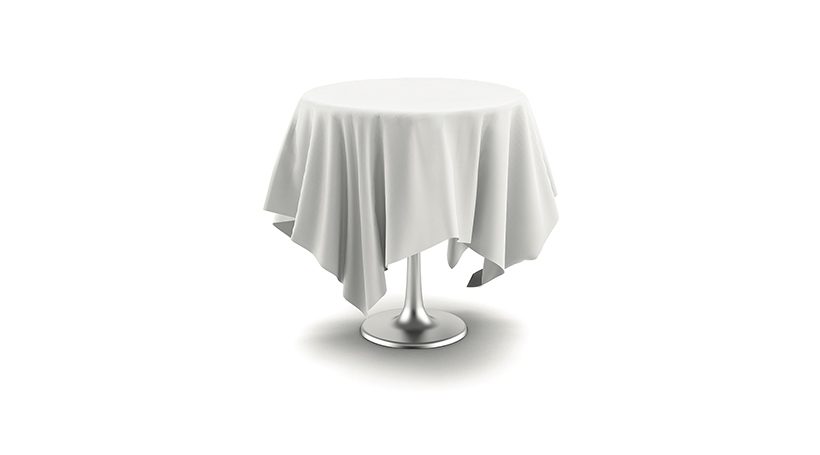It’s a key moment for South Jersey restaurants. After months of lockdowns and limitations, the industry is faced with its biggest challenge ever: pivot or perish. As we all wait to see when – or if – “eating out” will ever return to what it once was, those in the food industry are trying to find their place at the table, even when no one knows what exactly the table looks like or how many people it can hold or what else might also be at the table. The only thing they do know is how important it is to remain in business. For some, survival means saving the family business. But for all, it means they get to continue to feed a community they love.
—
In the best of times, the restaurant industry operates on a knife’s edge. Profit margins in successful years average around 5 percent. But most often, it’s half that. Few restauranteurs are in it for the money: for many, feeding their community and keeping a family business open is a labor of love.
As we all have seen, 2020 has not brought the best of times. Since early spring, the Covid-19 pandemic has ravaged nearly every industry in South Jersey. But perhaps no sector of the business community has been harder hit than restaurants, eateries, bakeries and cafes. Many have been shuttered since they were ordered to close their dining rooms on March 16 in an effort to stop the virus’ spread. Those who could, pivoted to curbside pick-up and take-out service. In June, those with available outdoor space started serving meals in the open air. But for many, weeks and weeks of reduced business – and tables inside that may continue to sit empty for who knows how long – will be a push off the edge.
“We know that maybe 50 percent of the restaurants in the country will go bankrupt,” says Barry Kratchman, owner of Classic Cake Bakery & Café. Kratchman says the majority of his profits come from wholesale contracts, so he’s ok. But he’s deeply concerned for his peers in the industry. “They’re just not going to survive. We’re seeing a resurgence in outdoor dining right now, sure, but what will happen in the fall when the weather’s too cold?”
And even as the state loosened some restrictions last month, Kratchman thinks it might be too little, too late. “I think that what some restaurants are finding now is they lose more money being open than being closed,” he says. “That’s the sad reality. For small businesses that don’t have a wide pocket, it’s like, ‘Ok, now I have to operate my restaurant on a 30 percent scale.’ So I do believe there’s going to be a shakeout.”
It’s not all bad news though: With the support of their loyal customers, many eateries – some considered South Jersey institutions – will survive. What will it be like to eat there? Well, that’s another question.
Turning to Takeout
Like most people at the pandemic’s outset, Bonnie-Lynn Schneider thought the stay-at-home order might last 2 weeks or so. “Then you’re at 30 days, then 45. Then we started thinking, ‘What are we going to do?’” The 5th-generation manager of
Pic-A-Lilli Inn in Shamong says a big plus was that she had enough staff to ramp up takeout service. “Our college kids didn’t go back to school or had already come home, so we built a team that became a big part of what kept us in this game.”
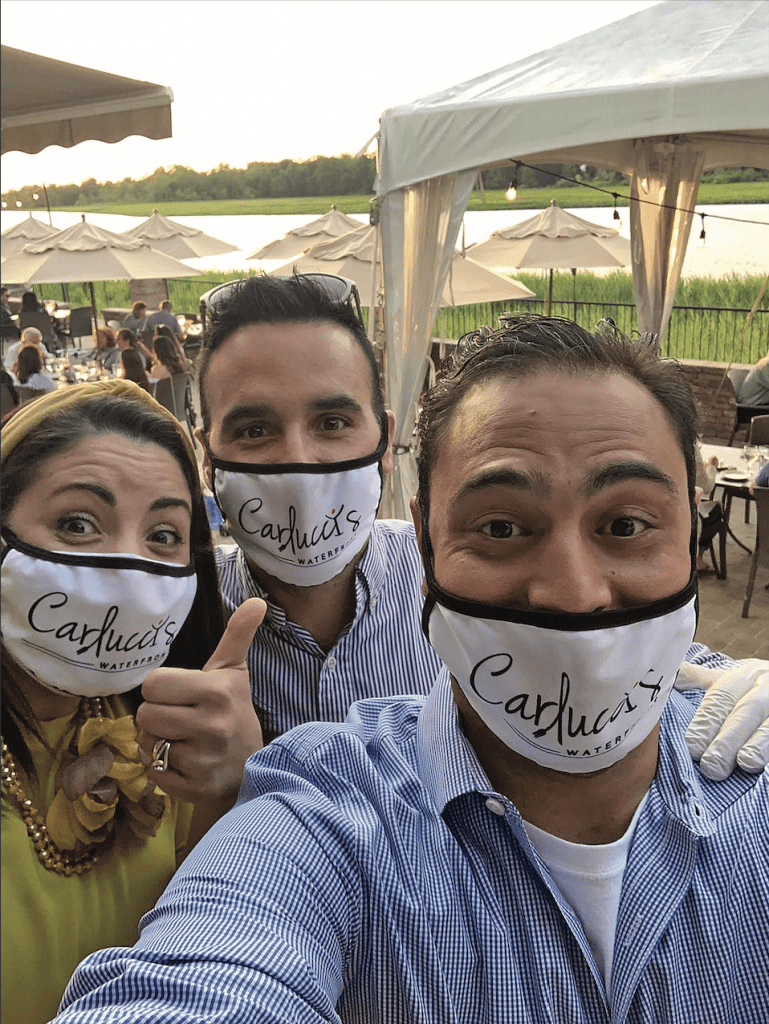
Carlo, Rosaria and Carlo Capuano, Managing Partners of Carlucci’s Waterfront
Schneider’s philosophy was simple: Treat every day like it’s the Super Bowl. “That’s our biggest day for takeout,” she says. “It’s all hands on deck. That’s what we started doing all the time. Somebody works the register, runners are going out to cars, expediters are making sure absolutely everything they need is in that bag.”
Pic-A-Lilli is continuing to operate, Schneider estimates, at 35-40 percent of its typical business. Still, she never considered throwing in the towel, and that’s probably the establishment’s saving grace.
“If we’d walked in that first day and said, ‘Ok, we’re going home,’ we would never have come back.”
While Schneider’s team was used to handling takeout orders, restaurants that relied more on the dine-in experience faced a tougher shift.
“We do showers, we do banquets – it’s fine dining,” says Carlo Capuano, general manager of Carlucci’s Waterfront in Mt. Laurel. “We don’t do takeout, really. We’re not that convenient to get to – we’re not in a shopping center. Dining here is about the experience.”
Carlucci’s closed for several weeks, and then, after Easter, got a special liquor
license to deliver beer and wine.
“It was just me in here by myself,” Capuano says. “I’d go drop it off on the doorstep.”
Soon after, the restaurant started offering family-style takeout packages, which were instantly popular, and offered a ray of hope for the restaurant.
“It just took off,” says Capuano. “We started doing delivery, just me and my two cousins. Mother’s Day was a huge success. We took orders up until the day before, then timed curbside pickups for every hour. It was our first real solid day.”
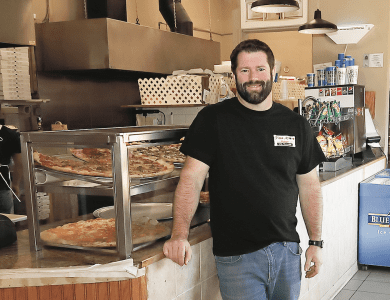
Pizza Amore and Philly Pretzel Factory Moorestown owner James McCracken | Photo: Jaclyn Savitz
A Struggling System
The dining industry involves more than chefs, servers and diners. It’s a complex supply chain – one that began splintering with the first closures. James McCracken’s Philly Pretzel Factory Moorestown was supplying pretzels to the Moorestown, Delran and Mt. Laurel school districts, plus a handful of delis and office buildings when Covid-19 hit.
“All of our wholesale just completely stopped,” McCracken says. “We tried to hang on for a couple of weeks, but eventually closed.”
The Philly Pretzel Factory recently reopened, but it’s doing less than half its usual business.
“It’s not just about us,” McCracken says. “Think about the bakery supplier: If we’re operating at 40 percent, they are too. You hope that everybody survives it, but I can tell you if this goes on for another 6 to 8 months, a lot of people won’t.”
He was recently at a popular high-end restaurant with his family, and “they were using I think 5 tables. You can’t operate like that for very long.”
McCracken also owns Pizza Amore in Delran, where takeout has always been popular so sales stayed consistent during the quarantine. “I think people have been really into supporting local establishments,” he says. But supply chain issues have affected him there, too. “I took veal off the menu. I was having a hard time getting it.”
At Pic-A-Lilli, Schneider hasn’t been able to get the ribs she typically orders.
“Things have really changed,” she says. “When it comes to paper products, you get what you can get. And beer…I couldn’t get a can of Corona if I wanted one. You really can’t even get kegs. No one is doing draft beer, there’s no one open to sell it, and cans are going to liquor stores because they can sell the volume.”
Opting Outside
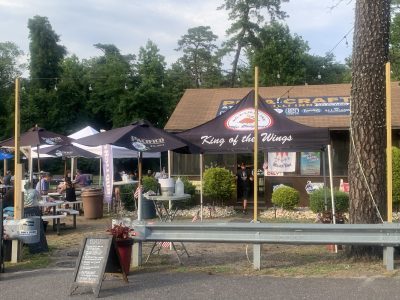
Pic-A-Lilli expanded its outdoor seating
There may have been a time when Pic-A-Lilli’s location – on a lonely rural road in the Pine Barrens – could be considered less than ideal for drawing in customers. But with indoor dining still banned, and business moving outdoors, Schneider’s thanking her lucky stars.
“We have a yard. We have the property to put people on.” They’ve added more tables to the patio and hung lights and décor to make the space more inviting. Business is slowly ramping up as the summer wears on, but she’s still working with a smaller staff.
“We eased into it because we didn’t know what we were capable of doing,” Schneider says. “Not having a full staff, what could we really do? We made adjustments to the menu, cutting things that required 2 or 3 extra steps.”
At Carlucci’s, outdoor dining has always been a selling point. Capuano says more lights, shades and fans have been installed on the restaurant’s patio on the banks of the Rancocas Creek. He and his team are also using an abundance of caution when it comes to contagion containment.
“Before we opened, the bussing team had a full-day meeting about cleaning the tables,” Capuano says. “We brought in a disinfection machine and set up hand sanitizing stations.”
The patio’s been busy every day since it re-opened.
“Mentally, you cannot be locked up in your house,” Capuano adds. “People want to be out and breathe fresh air. It’s important to be out and around other people.”
Adjusting and Adapting
For Classic Cake, the pandemic has only been one in a string of recent catastrophes. In early March, the bakery’s Cherry Hill location caught fire and burnt to the ground. Kratchman was quick to announce plans to find a new location and rebuild, but a few weeks later Covid-19 threw a wrench into those plans.
“Our building process is delayed by at least 2 or 3 months,” Kratchman adds. The silver lining, he says, is that designs for the new building can take into account health and safety concerns that most likely aren’t going away anytime soon.
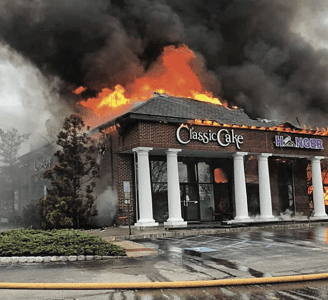
Classic Cake’s Cherry Hill location caught fire in March
“We’re taking time to think about when we do open, what will it look like? We’ll offer curbside service, reduce interaction, offer masks with consultations,” he says. “We’ll have temperature checks in our store, handwashing and sanitizing.”
For now, Classic Cake is serving clients out of the storefront of their longtime neighbor, Short Hills Deli. While many events that call for big cakes are off for now, Kratchman says the bakery is still getting between 30 and 50 orders a week.
“The cakes we’re making are smaller,” he says, “but celebrations aren’t going anywhere.”
Schneider expects the industry will experience some fundamental changes over the coming months and years. She wonders if one of the first will be shorter hours.
“After 10 pm on a Friday night, there’s nobody left on the highway now,” she says. “In normal business days it was just starting to slow down at 10 on weekdays. Now, it’s just about dead by 8. If we stayed open until midnight like we used to it would be a waste of time and money.”
But hardship breeds innovation, so she also anticipates bringing in more technology as progress marches, however slowly, on.
“Our point-of-sale system is already touchless,” she says. “There are QR codes on our menus so you don’t have to touch anything. We’re not fully there, but options are coming.”
Times are tough, and there’s no way around it. But Capuano – and many of his fellow South Jersey restaurateurs – intends to stick this thing out.
“Being in this business and being a pessimist doesn’t work,” he says. “That’s the thing about the restaurant business. Every time you think it’s an easy day, there’s something you’ve got to deal with. You have to be optimistic, or you get dragged down. Day by day, whatever happens, whatever changes there are, we’re going to find a way.”


